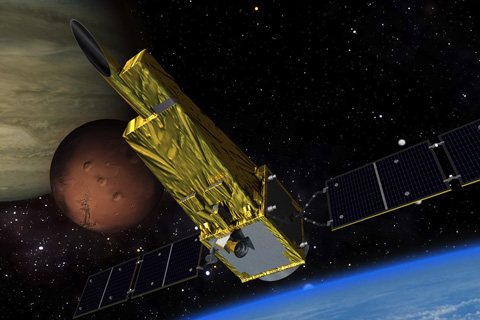About Extreme ultraviolet spectroscope for Exospheric Dynamics "HISAKI" (SPR)
 |
World’s first space telescope to observe planets!Spectroscopic Planet Observatory for Recognition of Interaction of Atmosphere "HISAKI" (SPRINT-A) is the world's first space telescope for remote observation of the planets such as Venus, Mars, and Jupiter from the orbit around the earth. Venus and Earth may be called twins planet, and it recently becomes clear that three terrestrial planets in the solar system including Mars have very similar environment in the beginning era of the solar system. However, in three planets, which could be called the brothers, during the finite period within one billion years after the birth of the solar system each environment evolution of growth and change results into the different and specific current state. At Venus, it became the very dry atmosphere consisting mainly of carbon dioxide as a result that water ran away to outer space, and it is now the scorching world where the temperature of its surface reaches 400 degrees Celsius by the strong greenhouse effect. On the other hand, in Mars, most of atmospheric carbon component producing the greenhouse effect run away to outer space, and it is now in the chilly world. |
|---|
In the Spectroscopic Planet Observatory for Recognition of Interaction of Atmosphere "HISAKI" (SPRINT-A) mission, the mechanism that the atmosphere of these terrestrial planets runs away to outer space is one of scientific objectives. Because in the beginning era of the solar system the sun had more intensely activity than the present, and because the very strong solar wind arrived at the planet, it is in particular thought that a large quantity of atmosphere ran away. The study on interaction of the strong solar wind on the atmosphere of the planet leads to acquiring knowledge of history in the early stage of the solar system.
Furthermore, Spectroscopic Planet Observatory for Recognition of Interaction of Atmosphere "HISAKI" (SPRINT-A) will also perform an observation of extreme ultraviolet light from the satellite Io of the Jupiter, and examines how to transfer energy in the plasma environment of the Jupiter from an observation of a sulfur ion flowing out from Io.
Project Topics
indexA new map of temperatures in Jupiter’s upper atmosphere reveals a solution to the planet’s “energy crisis”
|
Overview: the aurora that heats a planet Sitting more than five times the distance from the Sun as the Earth, Jupiter is not expected to be particularly warm. Based on the amount of sunlight received, the average temperature in the giant planet’s upper atmosphere should be about 200 K or a chilly -73 Celsius. Instead, the measured value sits around 700 K or 420 Celsius. The source of this global heat has remained elusive for 50 years, causing scientists to refer to the discrepancy as ... |
Press Release
index-
- Mar. 25, 2015 (14:00) [release]
- Aurora Explosion on Jupiter caused by Rapid Rotation
Major Characteristics
| International Designation Code | 2013-049A | |
|---|---|---|
| Name | Spectroscopic Planet Observatory for Recognition of Interaction of Atmosphere "HISAKI" (SPRINT-A) | |
| Objectives | Jupiter's Io torus and Planetary exospheric escape by an EUV spectroscopy observation | |
| Launch | Date | 14:00, September 14, 2013 (JST) |
| Location | Uchinoura Space Center (USC) | |
| Launch Vehicle | Epsilon | |
| Configuration | Weight | 348kg |
| Orbit | Altitude | Apogee 950km, Perigee 1150km |
| Inclination | 31° | |
| Type of Orbit | Elliptical | |
| Period | about 106min. | |
| Scientific Instruments (Planned) | Extreme-ultraviolet (EUV) imaging spectrometer | |
